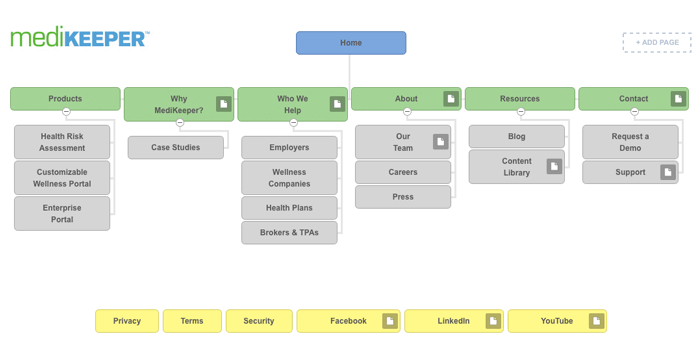The idea of creating compelling B2B website content may sound overwhelming at first, but it doesn’t have to be. Here at Bop Design, I’ve crafted the website content strategy for a number of B2B clients and I’ve learned what works, what doesn’t, and what to do to ensure we consistently launch websites with winning content that generates new business.
The seven tips below provide a solid road map for you to craft B2B website content that sells.
-
Start with your sitemap
Before you write a single line of copy, draft your sitemap: a hierarchical list of all the pages on your website and how they relate to one another.
We created the sitemap below for MediKeeper, a company that develops healthcare portals. Naturally, it starts with the home page at the top. The next line down features the top-level pages – the pages that will appear on your main navigation. Below the top-level pages are the sub-pages. (In some cases, there will be sub-pages to the sub-pages, depending on how large your site is.)

The sitemap provides a jumping off point that organizes the pages on your site in a clear-cut manner and helps you plan your B2B content strategy. Keep in mind that the sitemap is meant to represent just the pages on your site. It’s not a comprehensive catalog of every copy point you want to make. In essence, think of the pages on your site as content categories that will make sense to your prospective clients. You can then drill down and make notes on which copy points to make on each page.
-
Create your overarching brand message
While you may be tempted to dive right in and start writing page copy, it’s important to have a content strategy at the outset. What is the main message you want to convey about your brand? All too often we come across clients who aren’t clear about what makes their brand unique. Determine what sets you apart from your competitors and craft a story around your brand that positions you as the company best suited to serve your clients’ needs.
In the example of our client MediKeeper, we created the overarching brand message, “Workforce health just got easier.” They are communicating to clients that their wellness portals provide a simple solution to the complex job of managing workforce health – something many HR managers struggle with.
Your overarching brand message should guide you when crafting the remainder of your B2B website content. Ask yourself, “Does the copy I’m writing convey the overarching brand message?” The answer should be yes.
-
Get to the point
While you may be skilled at writing beautiful prose or clever headlines, if it doesn’t immediately get to the point of a) what you do and b) how it can help potential customers, it’s not worth much in a B2B marketing context. Business folks are busy and they simply don’t have time to poke around your site just to figure out what it is you do.
You’ve got about 10-20 seconds to engage your website visitors once visitors land on your site, and that means letting them know they’re in the right place. If they’re searching for payroll software, don’t make them work to figure out that’s what you provide. Make sure this information appears front and center to get them to dig deeper to find out if you’re the right payroll software provider for them.
However, when we say “get to the point,” we’re not just talking about the home page. Use this principle on all of your website pages. The internet is bursting at the seams with more and more content daily – and as content volume grows, attention spans shrink. That’s why we’ve seen a trend of “simplify or perish” when it comes to content. Avoid long blocks of copy and make your point succinctly, yet effectively.
-
Speak like a human
Yes, you’re representing a B2B business, but don’t make the mistake of forgetting that your buyer is actually a living, breathing human being with thoughts and emotions. In this age of social media, even the most traditional, corporate sites are adopting more conversational tones in their website content. Why? It’s simply more engaging.
So, stop referring to yourselves in the third person, ditch the dull corporate speak and start talking to your audience like people. While you may not want to sound too laid back (leave the emojis and “LOLs” for texting friends and family), a skilled copywriter will understand the difference between conversational and cutesy.
-
Solve your client’s pain points
All too often, we come across B2B websites that go on and on about how awesome they are. That’s nice, but your website visitor is thinking, “But how are you going to solve MY problem?”
The first step is to determine the role of your buyer. A mid-level marketing manager will have different pain points than a CEO. Chances are a lower-level administrator will do the initial research of identifying possible vendors, and then make recommendations to the executive team. You want to make sure you are covering the pain points of all of your buyer personas.
Let potential clients know that you understand their pain points by stating what they are. Then be explicit at explaining how your product or services can help eliminate them.
-
Make CTAs clear and concise
Now that you’ve written amazing copy on how you can solve your client’s problems – and convinced them that you’re a great fit, make it easy for them to contact you. Provide clearly visible calls-to-action (CTAs) throughout your site and on your navigation that prompt them to get in touch.
Perhaps offer a free consultation, product demo, or just an opportunity for them to reach out with questions. Again, make it easy. Provide a short form they can fill out right then and there – with “short” being the operative word. Make it simple for them and they’ll be more likely to complete the desired action: contacting you about your offering.
-
Work with a skilled B2B website designer
While they say content is king, you can think of design as queen. Think about a standard text document. You could write the most compelling, persuasive content ever, but it’s not going to do much for you if you present it in that format.
The right designer – one who is experienced in working with B2B websites –knows how to make your copy pop and motivate potential buyers. They know how to break up content for maximum readability and understand which copy needs to stand out most.
Avoid designers who design simply for the sake of design. A stunning design alone won’t do the job. You need a designer who understands that B2B marketing has a purpose – and that purpose is to sell.
Ready to get started with your B2B website project? Contact us today to get a personalized assessment of your B2B website and a custom quote.



